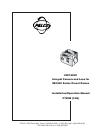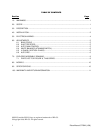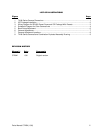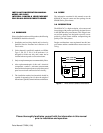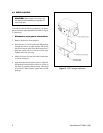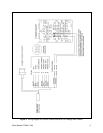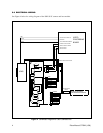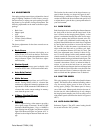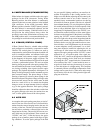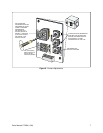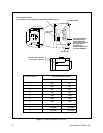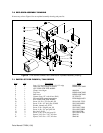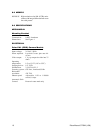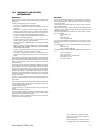
Pelco Manual C720M (1/96) 5
6.0 ADJUSTMENTS
Your optics package comes factory adjusted for a broad
range of lighting conditions. For this reason, you may
find it necessary to adjust your optics package to tailor
the picture to your specific viewing environment. The
following adjustments can be made to the Pelco optics
package.
• Back focus
• Shutter speed
•AGC
• White balance
• V-Phase (Vertical Phase)
• Auto iris level
The factory adjustments for the above controls are set
as follows:
➤
Back Focus
Adjusted with focus far/zoom wide looking at an
object 55 feet (16.76 m) from the lens. The results
are a clear, in-focus picture through the entire zoom
range (reference Figure 5 for back focus adjust-
ment location).
➤
Shutter Speed
Factory set to the slowest speed available: 1/60
second on NTSC units; 1/50 second on PAL units.
➤
Auto Gain Control
AGC ON/OFF set to ON.
➤
White Balance
White balance has two positions; one is ATW (Au-
tomatic Tracing White), which is a feature that
continuously adjusts the camera for optimum color
reproduction. AWB (Automatic White Balance) is
a feature that retains current settings in memory
even when the power is off.
➤
V-Phase (Vertical Phase)
See section 6.5.
➤
Auto Iris
Level is adjusted using a video meter to provide a
video signal output of between 130 and 142 IRE
(Institute of Radio Engineers; 1V p–p = 100 IRE's)
when lighting from skylights, low pressure sodium
lights and fluorescent lights are present. ALC is
adjusted to the midpoint between Peak and Aver-
age.
The location for the controls of the above features, ex-
cept for back focusing, are shown in Figures 6 and 7.
Back focusing is addressed in Figure 5. The following
sections will define the above features and specify how
to adjust them to gain the best system performance in
your environment.
6.1 BACK FOCUS
Back focusing involves controlling the distance between
the focal point of the lens and the image head. If the
lens is focused on the imaging head properly, a clear
picture is maintained through the entire zoom range.
The optics package has been back focused at the fac-
tory. In some cases, additional back focusing may be
required. Should this be the case, back focus is adjusted
by moving the lens positions to zoom wide and focus
far. Once this is done, the camera is positioned on an
object with clean lines such as a window seal, shelf,
etc., at a minimum distance of 55 feet (16.76 m). The
back focus adjustment screw location is shown in Fig-
ure 5. It can be adjusted with a small standard straight
slotted screwdriver. The screw itself is recessed a bit
from the camera housing as indicated in the figure. The
mechanical movement of the screw as the screwdriver
is turned is about three “clicks” or indents in either di-
rection. As you move the back focus set screw back
and forth, the distance between the lens and image head
moves in and out. You will be able to see the clean line
come in and out of focus. Continue to adjust the screw
back and forth until the optimum focus is obtained.
6.2 SHUTTER SPEED
This optics package is provided with adjustable shutter
speeds. This feature allows minimal streaking when a
very fast moving object passes in front of the non-
moving optics package. The shutter speed is factory
set to 1/60 second. Shutter speed selection does not af-
fect the auto iris video feedback loop. It only changes
the imaging head sampling rate. You can select one of
eight shutter speeds (reference the details in Figures 6
and 7).
6.3 AUTO GAIN CONTROL
Reference Figure 6. The AGC control setting should
be set and left in the “ON” position.



